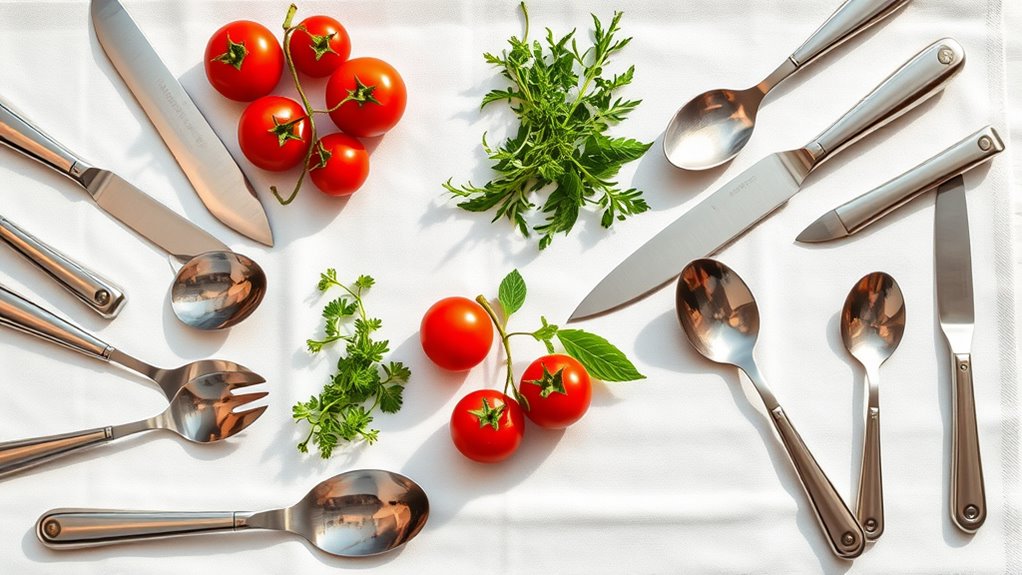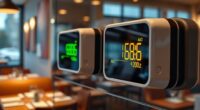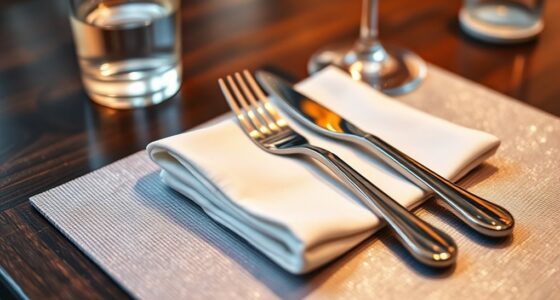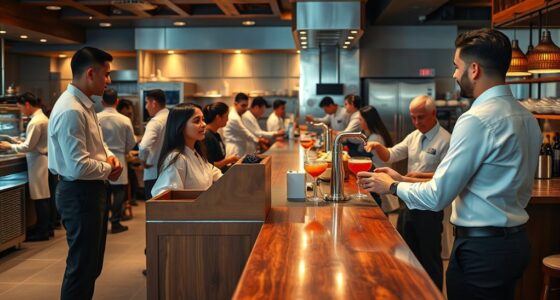Mise en place is all about organizing your station before cooking. It means gathering, prepping, and arranging ingredients and tools for efficiency and consistency. By setting up your workspace with everything in its place, you reduce stress, save time, and improve the quality of your dishes. Proper setup helps prevent mistakes and keeps you focused. Keep exploring to discover tips that can elevate your kitchen skills and streamline your cooking process.
Key Takeaways
- Mise en place is a French term meaning “everything in its place,” emphasizing preparation and organization in cooking.
- Proper station setup involves organizing tools, ingredients, and workspace for efficiency and safety.
- Key techniques include grouping similar ingredients, pre-measuring, and arranging items for logical workflow.
- Benefits include reduced prep time, consistent results, minimized errors, and a stress-free cooking environment.
- Adapting station layouts to specific cuisines and tools enhances functionality and promotes professional kitchen standards.
Understanding the Origins and Meaning of Mise En Place

Have you ever wondered where the phrase “mise en place” comes from and what it truly means? It’s a French term that translates to “putting in place” or “everything in its place.” Originating in classical French cuisine, it emphasizes the importance of preparing and organizing ingredients and tools before cooking. Chefs adopted this practice to streamline their workflow, reduce mistakes, and save time during busy service hours. By understanding its roots, you realize that mise en place isn’t just about neatness — it’s about efficiency, discipline, and precision. This approach guarantees that everything you need is ready and within reach, making your cooking process smoother and more enjoyable. Knowing its origin helps you appreciate the discipline behind this essential kitchen habit. Additionally, embracing predictive analytics in culinary planning can help optimize ingredient usage and reduce waste, further enhancing the efficiency of mise en place.
The Key Components of an Efficient Station Setup
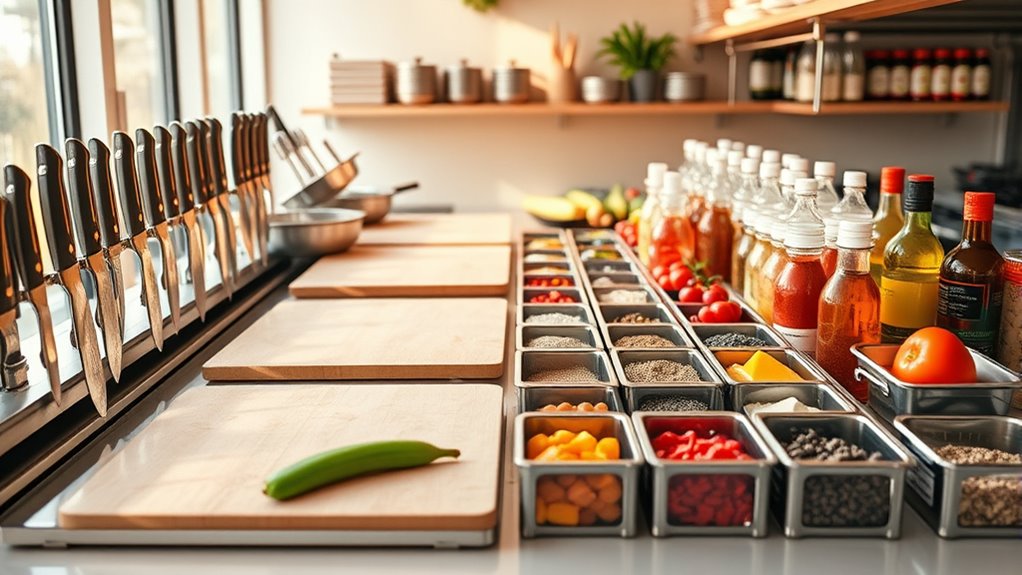
A well-organized station setup is the backbone of efficient cooking, ensuring everything you need is within easy reach and neatly arranged. Start with clearly defined zones for prep, cooking, and plating. Keep frequently used tools like knives, spatulas, and tongs close at hand, preferably on a magnetic strip or in accessible containers. Use labeled containers or small bowls for ingredients, so you’re not wasting time searching. Maintain a clean workspace, removing clutter regularly. Make sure your cutting boards are stable and your cookware is within reach but not overcrowded. Proper lighting is essential to see clearly and work safely. Additionally, understanding wax-free candle techniques can inspire creative decor ideas or repurposing materials for your setup. By focusing on these key components, you streamline your workflow, reduce stress, and create a more enjoyable cooking experience.
Benefits of Practicing Mise En Place in Your Kitchen

Practicing mise en place helps you save time and effort by organizing everything before cooking. It also leads to more consistent results, so your dishes turn out just the way you want. Plus, it reduces kitchen chaos, making your cooking experience smoother and more enjoyable. Being familiar with the Vetted electric bike conversion kits available can inspire you to incorporate innovative and efficient tools into your culinary setup, emphasizing the importance of preparation and organization.
Saves Time and Effort
When you organize and prepare ingredients ahead of time through mise en place, you considerably reduce the time spent searching for tools or last-minute prep work. This streamlined approach keeps your station tidy and focused, allowing you to work faster. Instead of wasting minutes hunting for a spatula or measuring spoons, everything is ready to go. Here’s how it benefits you: creating the perfect ambience and setting the tone for an efficient cooking environment.
| Benefit | How it Helps |
|---|---|
| Faster cooking | Less time searching, more cooking |
| Less stress | Less last-minute chaos |
| Increased efficiency | Smooth, continuous workflow |
Ensures Consistent Results
Have you ever noticed how following a recipe precisely yields the same delicious results each time? That consistency comes from careful preparation, and mise en place plays a key role. When you organize ingredients and tools beforehand, you eliminate guesswork and shortcuts. You know exactly what to add and when, reducing errors and variations. This discipline helps you develop a rhythm, ensuring each dish turns out just right. Over time, practicing mise en place trains your skills to become more precise and reliable. Whether you’re cooking for family or guests, this method guarantees predictable, high-quality results every time. Consistency builds trust in your cooking, boosts confidence, and makes your kitchen a place of dependable excellence.
Reduces Kitchen Chaos
Organizing your ingredients and tools ahead of time keeps your kitchen from becoming a chaotic mess. When everything is in its place, you won’t waste time searching for utensils or ingredients mid-recipe. This streamlined approach helps you stay focused and reduces stress, especially during busy cooking moments. With a clear setup, you avoid last-minute scrambling and accidental spills or forgotten steps. Mise en place encourages you to think ahead, which keeps your workspace tidy and safe. You’ll find that cooking becomes more efficient and enjoyable, as you’re not constantly interrupted by clutter or confusion. Ultimately, practicing mise en place helps you maintain control, making the entire process smoother and less overwhelming. Less chaos means more confidence and better results in your kitchen. Incorporating self watering plant pots into your home gardening routine can also help maintain consistent moisture for your plants, reducing the need for frequent watering and making plant care more manageable.
Step-by-Step Guide to Organizing Your Cooking Station
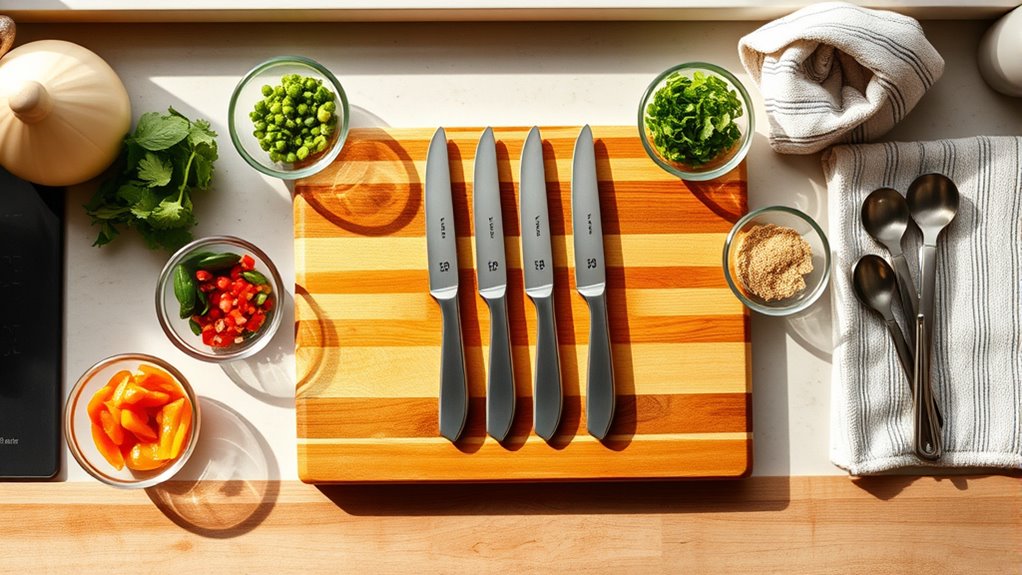
To get started, gather all the essential tools you’ll need for your cooking session. Then, arrange your ingredients strategically so everything is within easy reach. This setup helps you work efficiently and keeps your station organized throughout the process. Additionally, consider projector placement to ensure a clear viewing experience if you’re incorporating visual aids or entertainment into your setup.
Subheading 1: Gather Essential Tools
Before you start cooking, it’s vital to gather all the tools you’ll need, ensuring your workspace is efficient and clutter-free. Having everything on hand prevents interruptions and keeps your workflow smooth. Start by collecting basic tools like knives, cutting boards, measuring cups, spoons, and mixing bowls. Check that your equipment is in good condition—sharp knives and clean tools make a difference. To help you visualize, here’s a quick reference:
| Tool | Purpose | Tip |
|---|---|---|
| Chef’s Knife | Chopping, slicing | Keep sharp for safety |
| Cutting Board | Prep ingredients | Use separate boards for meats and veggies |
| Measuring Cups | Accurate ingredient portions | Level off for precision |
Gather these essentials before you begin for a seamless cooking experience. Proper organization of your tools and equipment can significantly enhance your cooking efficiency.
Subheading 2: Arrange Ingredients Strategically
Once you’ve gathered your tools, the next step is to arrange your ingredients strategically to streamline your cooking process. Place frequently used items like salt, pepper, and oils within easy reach. Group ingredients by their roles in the recipe—vegetables together, spices in one spot, proteins in another. Use small bowls or containers to pre-measure and hold ingredients, preventing clutter and saving time. Keep everything organized so you can quickly grab what you need without searching. Position ingredients based on the order you’ll use them, working from left to right or top to bottom. This setup minimizes movement and helps maintain a smooth workflow, allowing you to focus on cooking rather than searching for ingredients. Proper arrangement makes your station more efficient and your cooking more enjoyable.
Essential Tools and Equipment for a Well-Prepared Kitchen
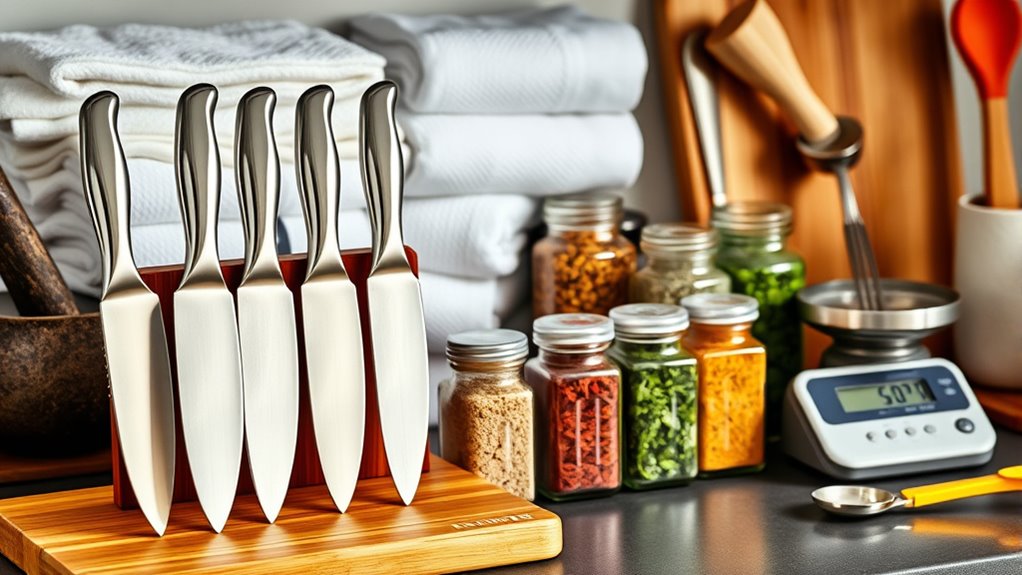
Having the right tools and equipment is essential for a well-organized kitchen, as they make food preparation more efficient and enjoyable. You need reliable essentials to streamline your workflow and maintain focus. Invest in quality kitchen knives, cutting boards, measuring spoons, and cookware. These tools should be accessible and suited to your cooking style. To help you prioritize, here’s a quick guide:
| Essential Tools | Purpose |
|---|---|
| Chef’s Knife | Precision chopping and slicing |
| Cutting Boards | Protect surfaces, prep ingredients |
| Measuring Spoons | Accurate ingredient portions |
| Non-stick Pans | Even cooking, easy cleanup |
Having these tools ready ensures your station is set for seamless meal prep and keeps your focus on creating dishes.
Techniques for Prepping Ingredients Effectively

To prep ingredients effectively, start by organizing them logically so everything is easy to access. Use the right tools for each task to save time and guarantee precision. Keep ingredients fresh and your workspace clean to maintain quality and efficiency throughout your cooking.
Organize Ingredients Logically
Organizing ingredients logically is essential for efficient cooking, as it helps you work smoothly and avoid unnecessary delays. Begin by grouping ingredients based on their role in the recipe—measures, spices, or fresh produce. Place frequently used items within easy reach to save time. Keep ingredients that require similar preparation steps close together, such as chopping or mixing. Use small bowls or containers to pre-measure or hold prepped ingredients, reducing clutter on your workspace. Label ingredients if necessary, especially if they look similar. Arrange ingredients in the order you’ll use them, so you can grab each item seamlessly. This logical setup minimizes movement and keeps your station tidy, allowing you to focus on cooking without searching for what you need. Incorporating organized storage solutions can further enhance your station’s efficiency and help maintain a clutter-free environment.
Use Appropriate Prep Tools
Using the right prep tools can make a significant difference in how efficiently you prepare ingredients. Sharp knives, for example, cut cleanly and quickly, reducing prep time and ensuring safety. Use a sturdy cutting board to provide stability and prevent slips. Measuring spoons and cups help you portion accurately, avoiding waste or mistakes. A mandoline slicer speeds up slicing tasks and ensures uniform thickness, while a food processor can handle chopping, pureeing, or shredding large quantities fast. Invest in quality tools suited to your tasks; inexpensive or inappropriate tools can slow you down and compromise results. Keep your tools clean and well-maintained to prevent cross-contamination and maintain their effectiveness. Choosing the right tools streamlines your prep process, making your station more efficient and your dishes more consistent.
Maintain Freshness and Cleanliness
Maintaining the freshness and cleanliness of your ingredients starts with proper handling from the moment you select them. Always choose high-quality, fresh produce, and inspect for any signs of spoilage. Store ingredients promptly in clean, airtight containers or appropriate packaging to prevent contamination and dehydration. When prepping, wash vegetables and herbs thoroughly under cold water to remove dirt and bacteria, then dry them completely with a clean towel or salad spinner. Use sanitized tools and surfaces to avoid cross-contamination. Keep raw meats separate from produce, and refrigerate perishable items immediately. Regularly clean your workstation, knives, and cutting boards to maintain hygiene. By handling ingredients carefully and maintaining cleanliness throughout, you ensure that your station stays safe, organized, and ready for efficient cooking.
Common Mistakes to Avoid When Setting Up Your Station
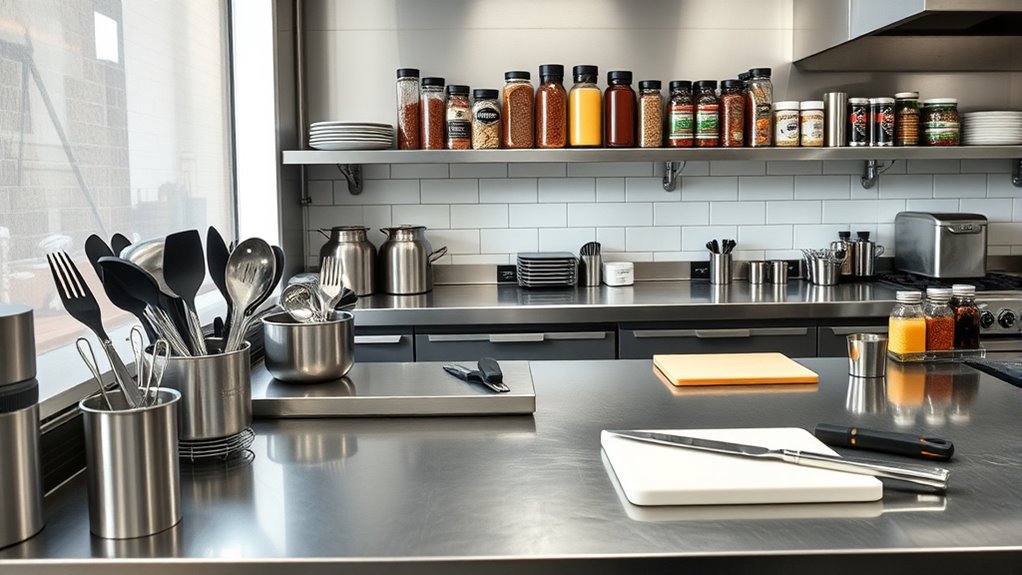
One of the most common mistakes when setting up your station is failing to plan ahead, which can lead to clutter, inefficiency, and delays during service. You might stuff your workspace with unnecessary tools or ingredients, making it harder to find what you need quickly. Overloading the station can cause confusion and slow you down. Another mistake is neglecting to organize items logically; placing frequently used tools or ingredients far from your reach wastes valuable time. Failing to check equipment beforehand can also cause issues, like broken appliances or missing utensils. Finally, rushing the setup process or skipping a proper layout can compromise safety and cleanliness. To avoid these pitfalls, always take the time to plan your station carefully, ensuring everything is within easy reach and well-organized before service begins.
Adapting Mise En Place for Different Types of Cuisine
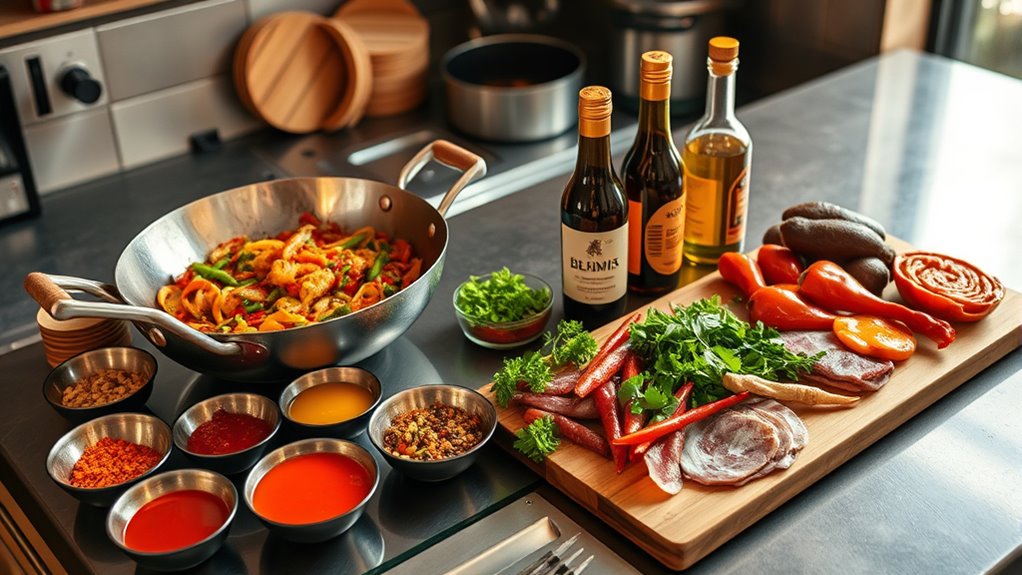
Adapting your mise en place to different types of cuisine requires understanding the unique ingredients, tools, and techniques each style demands. For example, Asian cooking often involves multiple small bowls for sauces, herbs, and prepped vegetables, while French cuisine emphasizes precise knife cuts and specific utensils. Italian dishes may require arranging herbs, cheeses, and cured meats nearby, reflecting their emphasis on fresh ingredients. Spices and seasonings should be prepared according to the cuisine’s flavor profiles. Keep in mind that certain cuisines demand specific equipment—like a wok or pasta pot—so have those ready. Adjust your station layout to accommodate these needs, ensuring everything is accessible and organized to streamline your cooking process. This tailored approach helps you work efficiently and authentically, no matter what cuisine you’re preparing.
Tips for Maintaining Organization During Cooking
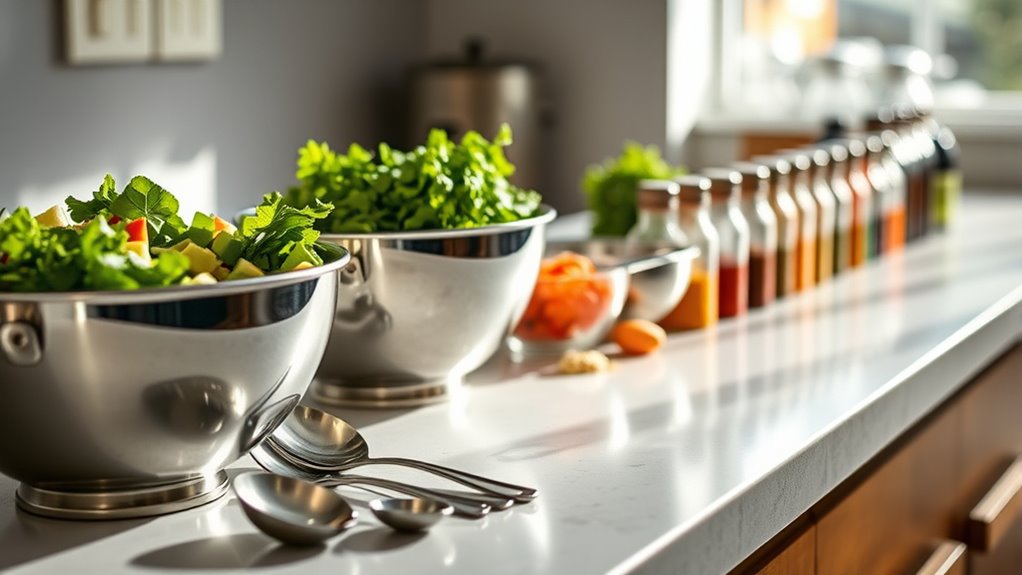
Staying organized while cooking can be challenging, especially when juggling multiple tasks at once. To stay on track, keep your workspace neat and clear as you go. Use bowls or containers to hold pre-measured ingredients, so you can grab what you need quickly. Clean as you cook—wipe down surfaces and wash utensils to prevent clutter from piling up. Work in stages, completing one step before moving to the next, which helps avoid confusion. Label ingredients and tools if necessary, so you always know where everything is. Keep your focus on the task at hand, and resist the urge to multitask unnecessarily. By maintaining a tidy station and following a logical flow, you’ll cook more efficiently and reduce stress.
How Mastering Mise En Place Can Improve Your Culinary Skills
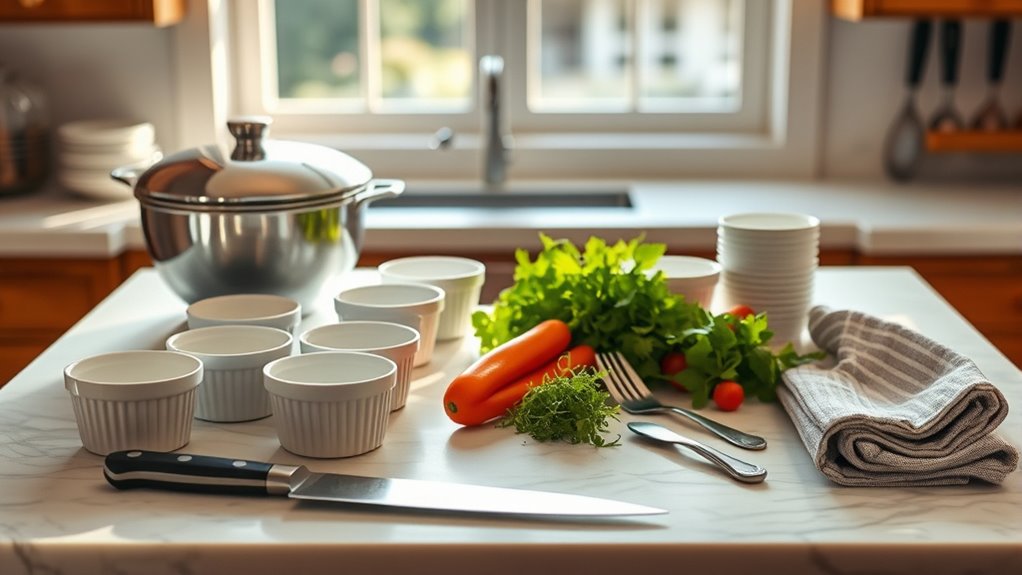
Mastering mise en place transforms your approach to cooking by fostering precision and efficiency. When you organize ingredients and tools beforehand, you reduce hesitation and stay focused. This preparation helps you cook faster and more accurately, minimizing mistakes. As you become more disciplined with station setup, your skills improve because you’re better at multitasking and timing. Consistent practice with mise en place sharpens your knife skills, enhances your understanding of recipes, and boosts your confidence in the kitchen. Over time, this habit encourages a more professional mindset and a deeper appreciation for process. Ultimately, mastering mise en place not only streamlines your cooking but also elevates your culinary abilities, making you more skilled, precise, and creative with every dish you prepare.
Frequently Asked Questions
How Long Does It Typically Take to Set up a Station?
Setting up a station usually takes about 10 to 15 minutes, depending on its complexity and your experience. You’ll gather everything needed, organize tools and ingredients, and make certain everything is within reach. If you’re well-practiced or working with a streamlined system, it can be quicker. Rushing might lead to mistakes, so take your time to set up efficiently. Proper preparation ensures smoother service and better results.
Can Mise En Place Be Adapted for Small or Shared Kitchens?
Imagine a compact kitchen where space feels like a puzzle piece, yet efficiency still reigns. You can adapt mise en place by organizing ingredients and tools in small containers, stacking them neatly, and labeling everything clearly. Use vertical storage and prioritize essential items. With a little creativity, even shared kitchens become well-oiled machines, making prep seamless and stress-free, no matter how tight the quarters are.
What Are Some Tips for Maintaining Organization During Busy Service?
During busy service, staying organized is key. Keep your workspace tidy by regularly wiping down surfaces and returning tools to their designated spots. Prioritize tasks, and don’t hesitate to ask for help if needed. Use visual cues like labels or color-coded containers to quickly identify ingredients. Maintain a calm mindset, stay focused, and adapt quickly to changes. These tips help you work efficiently and avoid chaos in a hectic kitchen.
How Can Beginners Start Practicing Mise En Place Effectively?
To start practicing mise en place effectively, you should begin by organizing your workstation before service begins. Gather all ingredients and tools, then prep everything in advance—wash, chop, measure, and arrange. Focus on creating a clean, logical setup that allows you to work smoothly. Practice these steps consistently, and over time, you’ll develop a rhythm that makes your workflow more efficient and confident during busy moments.
Are There Specific Storage Solutions Recommended for Mise En Place?
You should consider using clear, labeled containers for your ingredients to keep everything organized and easily accessible. Small bowls, magnetic strips for knives, and adjustable dividers can help maximize space and keep items sorted. Invest in stackable storage units or pull-out drawers to make the most of limited space. These solutions make your station efficient, reduce clutter, and help you focus on your cooking without wasting time searching.
Conclusion
Mastering mise en place transforms your kitchen into a flawless culinary battlefield where chaos is banished forever. With every ingredient perfectly in place, you’ll become a cooking superhero, turning ordinary dishes into extraordinary masterpieces in seconds. Push aside mess and disarray—because once you unseal this secret, your kitchen will never be the same. Get ready to conquer cooking with the precision and power of true mise en place mastery!
